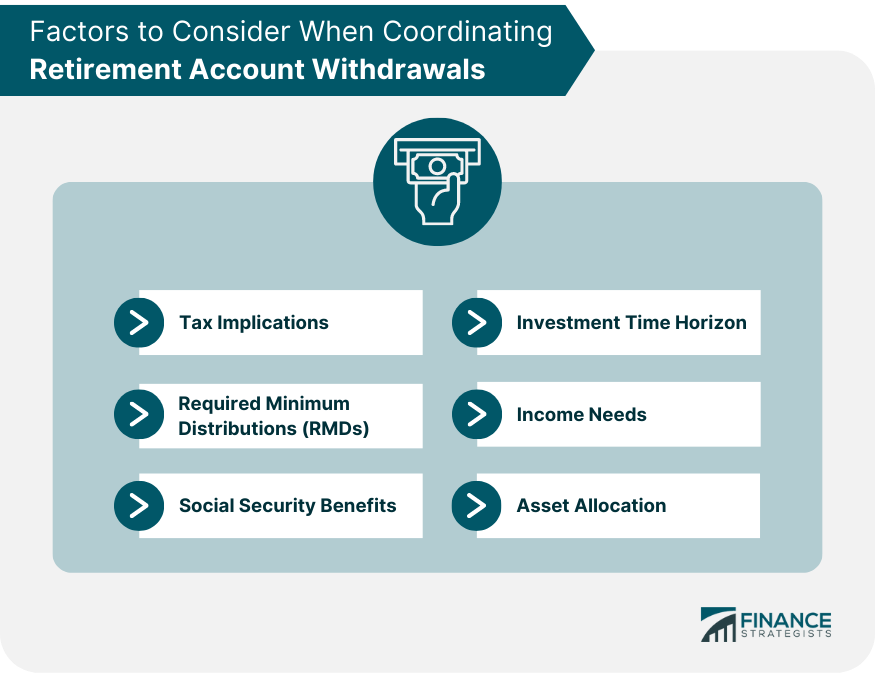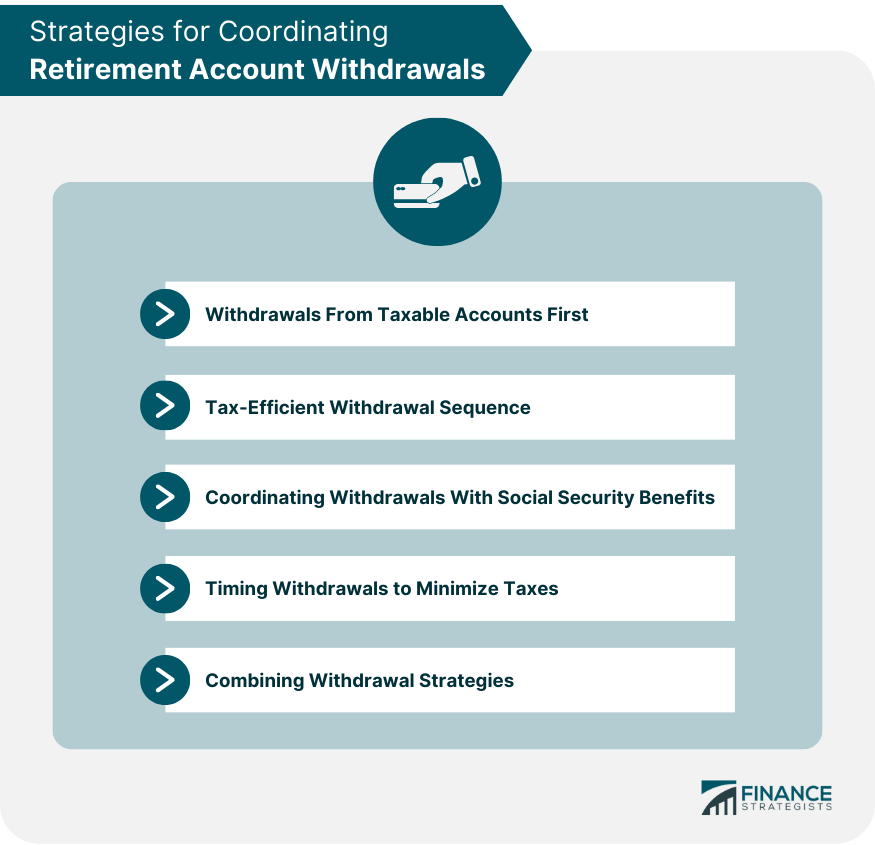Coordinating retirement account withdrawals is crucial for retirees to optimize their income, minimize taxes, and ensure financial stability throughout their golden years. A well-structured withdrawal plan allows retirees to make the most of their savings and investments while reducing the risk of outliving their assets. The primary objective of coordinating retirement account withdrawals is to create a sustainable income stream that addresses the retiree's financial needs while minimizing tax liability and preserving wealth for as long as possible. A traditional IRA (Individual Retirement Account) is a tax-deferred retirement account that allows individuals to contribute pre-tax dollars. Withdrawals from a traditional IRA are taxed as ordinary income, and required minimum distributions (RMDs) must begin at age 73. A Roth IRA is a retirement account that allows individuals to contribute after-tax dollars. Withdrawals from a Roth IRA are tax-free, and there are no RMD requirements for the original account owner. A 401(k) is a tax-deferred employer-sponsored retirement plan that allows employees to contribute pre-tax dollars. Withdrawals from a 401(k) are taxed as ordinary income, and RMDs must begin at age 73. A 403(b) is a tax-deferred retirement plan for employees of certain non-profit organizations, public schools, and churches. Similar to a 401(k), contributions are made with pre-tax dollars, and withdrawals are taxed as ordinary income with RMDs starting at age 73. Pension plans are employer-sponsored retirement plans that provide a defined benefit, usually based on the employee's years of service and salary. Pension income is typically taxed as ordinary income. Taxable investment accounts are non-retirement investment accounts that do not receive any tax advantages. Capital gains and dividends from these accounts are subject to taxes. Withdrawals from tax-deferred accounts, such as traditional IRAs, 401(k)s, and 403(b)s, are taxed as ordinary income. Coordinating withdrawals from these accounts can help manage tax liability and ensure a more tax-efficient retirement income stream. Withdrawals from tax-free accounts, such as Roth IRAs, are not subject to income taxes. Coordinating withdrawals from tax-free accounts can help minimize taxes and provide more flexibility in managing retirement income. Withdrawals from taxable accounts, such as capital gains and dividends, are subject to capital gains taxes. Coordinating withdrawals from taxable accounts can help manage tax liability and maximize after-tax income. RMDs are mandatory withdrawals from tax-deferred retirement accounts, such as traditional IRAs, 401(k)s, and 403(b)s, beginning at age 73. Coordinating withdrawals with RMD requirements can help avoid penalties and ensure a more tax-efficient retirement income strategy. Coordinating withdrawals with Social Security benefits can help optimize retirement income and reduce the impact of taxes on Social Security benefits. The retiree's investment time horizon, or the length of time their investments need to last, plays a critical role in coordinating withdrawals. A longer time horizon may require a more conservative withdrawal strategy, while a shorter time horizon may allow for more aggressive withdrawals. Understanding the retiree's income needs is crucial for coordinating withdrawals effectively. This information will inform the withdrawal strategy and help ensure that the retiree's financial needs are met throughout retirement. The retiree's asset allocation, or the mix of investments in their portfolio, can impact the sustainability and tax efficiency of their withdrawal strategy. Coordinating withdrawals with asset allocation can help manage risk and optimize retirement income. One common strategy is to withdraw funds from taxable accounts first, followed by tax-deferred and tax-free accounts. This approach allows tax-deferred and tax-free accounts to continue growing tax-free for as long as possible. Another strategy involves withdrawing funds in a tax-efficient sequence, considering the retiree's tax bracket, income needs, and the tax treatment of different accounts. This approach aims to minimize taxes and maximize after-tax income. Coordinating withdrawals with Social Security benefits can help optimize retirement income and reduce the impact of taxes on Social Security benefits. For example, retirees might choose to delay Social Security benefits and withdraw from retirement accounts earlier, or vice versa, depending on their financial circumstances and tax situation. Timing withdrawals to minimize taxes involves strategically withdrawing funds from different accounts in response to changes in tax laws, market conditions, or personal circumstances. This approach can help manage tax liability and ensure a more tax-efficient retirement income strategy. In some cases, retirees may benefit from combining multiple withdrawal strategies to optimize their retirement income and minimize taxes. A financial advisor can help develop a personalized withdrawal plan that incorporates various strategies tailored to the retiree's unique financial situation. Failing to consider the tax implications of withdrawals from different retirement accounts can lead to unnecessarily high tax bills and reduce the retiree's after-tax income. Ignoring RMD requirements can result in significant penalties and adverse tax consequences. It is essential to incorporate RMDs into the withdrawal strategy and ensure compliance with IRS rules. Not considering Social Security benefits in the withdrawal strategy can lead to suboptimal retirement income and increased taxes on Social Security benefits. Retirees should regularly review and adjust their withdrawal strategy in response to changes in personal circumstances, market conditions, or tax laws to ensure that their income remains stable and sufficient throughout retirement. Financial advisors can play a critical role in developing a personalized withdrawal plan that aligns with the retiree's financial goals, tax situation, and personal circumstances. They can help determine the optimal withdrawal sequence and provide guidance on coordinating withdrawals from different accounts. Financial advisors can also help monitor and adjust the withdrawal plan as needed to account for changes in personal circumstances, market conditions, or tax laws. This ongoing support can help ensure that the retiree's income remains stable and sufficient throughout their retirement. Working with a financial advisor can help retirees minimize taxes and optimize their retirement income through effective tax planning and coordination of withdrawals from different accounts. Coordinating retirement account withdrawals is essential for optimizing retirement income, minimizing taxes, and ensuring financial stability throughout retirement. By developing a well-structured withdrawal plan, retirees can make the most of their savings and investments while reducing the risk of outliving their assets. There are several strategies available to help retirees coordinate withdrawals from different types of retirement accounts. By carefully considering tax implications, RMDs, Social Security benefits, investment time horizon, income needs, and asset allocation, retirees can develop a withdrawal strategy that minimizes taxes and optimizes their retirement income. A knowledgeable financial advisor can provide invaluable support in developing a personalized withdrawal plan that aligns with the retiree's financial goals, tax situation, and personal circumstances. By working closely with an advisor, retirees can ensure that their withdrawal strategy is tailored to their unique needs, providing financial security and peace of mind throughout their retirement years.Coordinating Retirement Account Withdrawals: Overview
Types of Retirement Accounts
Traditional IRA
Roth IRA
401(k)
403(b)
Pension Plans
Taxable Investment Accounts
Factors to Consider When Coordinating Withdrawals
Tax Implications
Tax-Deferred Accounts
Tax-Free Accounts
Taxable Accounts
Required Minimum Distributions (RMDs)
Social Security Benefits
Investment Time Horizon
Income Needs
Asset Allocation

Strategies for Coordinating Retirement Account Withdrawals
Withdrawals From Taxable Accounts First
Tax-Efficient Withdrawal Sequence
Coordinating Withdrawals With Social Security Benefits
Timing Withdrawals to Minimize Taxes
Combining Withdrawal Strategies

Potential Pitfalls and Mistakes to Avoid
Ignoring Tax Implications
Not Considering RMDs
Overlooking Social Security Benefits
Failing to Adjust Withdrawal Strategy as Circumstances Change
Role of Financial Advisors in Coordinating Withdrawals
Personalized Withdrawal Plan Development
Ongoing Monitoring and Adjustments
Tax Planning and Optimization
Conclusion
Coordinating Retirement Account Withdrawals FAQs
Coordinating retirement account withdrawals refers to the process of managing withdrawals from different types of retirement accounts such as 401(k)s, IRAs, and pensions to maximize tax efficiency and minimize the risk of running out of money in retirement.
Coordinating retirement account withdrawals is important to ensure that retirees have a steady stream of income throughout their retirement years while minimizing their tax liabilities. Without proper coordination, retirees may be subject to higher taxes and run the risk of depleting their retirement savings too quickly.
Some strategies for coordinating retirement account withdrawals include taking withdrawals from taxable accounts first to allow tax-advantaged accounts to continue growing, using required minimum distributions (RMDs) as a guide for withdrawals, and converting traditional IRAs to Roth IRAs to create tax-free income streams.
Several factors should be considered when coordinating retirement account withdrawals, including tax implications, the types of retirement accounts held, expected future income, and long-term financial goals. It is important to work with a financial planner or tax professional to develop a coordinated withdrawal strategy tailored to individual circumstances.
Individuals should start coordinating retirement account withdrawals well in advance of retirement, ideally during their working years. This allows them to make strategic decisions about contributions to different types of retirement accounts and to plan for their retirement income needs. However, it is never too late to start coordinating withdrawals, and individuals can benefit from working with a financial planner or tax professional to create a strategy even if they are already retired.
True Tamplin is a published author, public speaker, CEO of UpDigital, and founder of Finance Strategists.
True is a Certified Educator in Personal Finance (CEPF®), author of The Handy Financial Ratios Guide, a member of the Society for Advancing Business Editing and Writing, contributes to his financial education site, Finance Strategists, and has spoken to various financial communities such as the CFA Institute, as well as university students like his Alma mater, Biola University, where he received a bachelor of science in business and data analytics.
To learn more about True, visit his personal website or view his author profiles on Amazon, Nasdaq and Forbes.











